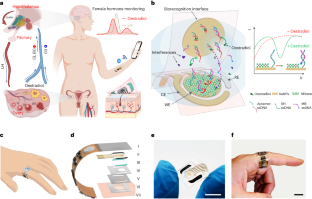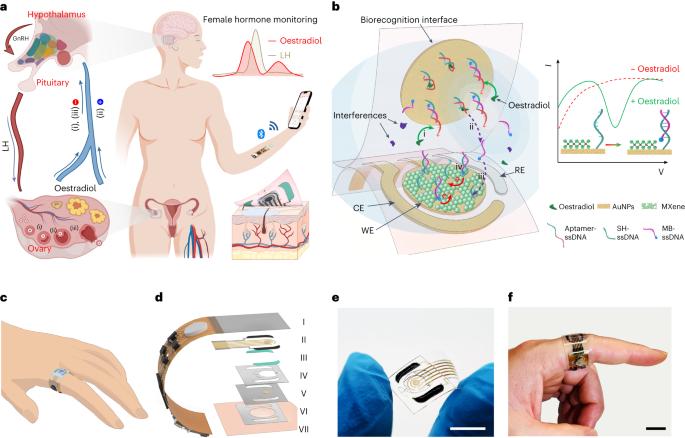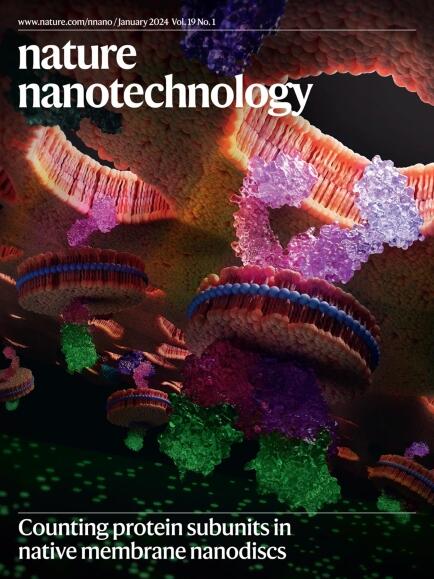A wearable aptamer nanobiosensor for non-invasive female hormone monitoring
IF 38.1
1区 材料科学
Q1 MATERIALS SCIENCE, MULTIDISCIPLINARY
引用次数: 0
Abstract
Personalized monitoring of female hormones (for example, oestradiol) is of great interest in fertility and women’s health. However, existing approaches usually require invasive blood draws and/or bulky analytical laboratory equipment, making them hard to implement at home. Here we report a skin-interfaced wearable aptamer nanobiosensor based on target-induced strand displacement for automatic and non-invasive monitoring of oestradiol via in situ sweat analysis. The reagentless, amplification-free and ‘signal-on’ detection approach coupled with a gold nanoparticle-MXene-based detection electrode offers extraordinary sensitivity with an ultra-low limit of detection of 0.14 pM. This fully integrated system is capable of autonomous sweat induction at rest via iontophoresis, precise microfluidic sweat sampling controlled via capillary bursting valves, real-time oestradiol analysis and calibration with simultaneously collected multivariate information (that is, temperature, pH and ionic strength), as well as signal processing and wireless communication with a user interface (for example, smartphone). We validated the technology in human participants. Our data indicate a cyclical fluctuation in sweat oestradiol during menstrual cycles, and a high correlation between sweat and blood oestradiol was identified. Our study opens up the potential for wearable sensors for non-invasive, personalized reproductive hormone monitoring. A reagentless, wireless, wearable aptamer nanobiosensor interfaced with a gold nanoparticle-MXene-based electrode enables the selective, automatic and non-invasive analysis of the female hormone oestradiol in sweat during menstrual cycles with subpicomolar sensitivity.


一种用于非侵入性女性激素监测的可穿戴适体纳米生物传感器。
对女性激素(例如雌二醇)的个性化监测对生育和女性健康非常重要。然而,现有的方法通常需要有创抽血和/或庞大的分析实验室设备,这使得它们很难在家里实施。在这里,我们报道了一种基于靶诱导链位移的皮肤界面可穿戴适体纳米生物传感器,用于通过原位汗液分析自动和非侵入性监测雌二醇。无反应、无放大和“信号开启”的检测方法与基于金纳米颗粒MXene的检测电极相结合,提供了非凡的灵敏度,检测极限为0.14 pM。这个完全集成的系统能够通过离子电渗法在休息时自主诱导汗液,通过毛细管爆裂阀控制精确的微流体汗液采样,实时雌二醇分析和校准,同时收集多变量信息(即温度、pH和离子强度),以及信号处理和与用户接口(例如智能手机)的无线通信。我们在人类参与者身上验证了这项技术。我们的数据表明,在月经周期中,汗液雌二醇存在周期性波动,汗液和血液雌二醇之间存在高度相关性。我们的研究为可穿戴传感器的非侵入性、个性化生殖激素监测开辟了潜力。
本文章由计算机程序翻译,如有差异,请以英文原文为准。
求助全文
约1分钟内获得全文
求助全文
来源期刊

Nature nanotechnology
工程技术-材料科学:综合
CiteScore
59.70
自引率
0.80%
发文量
196
审稿时长
4-8 weeks
期刊介绍:
Nature Nanotechnology is a prestigious journal that publishes high-quality papers in various areas of nanoscience and nanotechnology. The journal focuses on the design, characterization, and production of structures, devices, and systems that manipulate and control materials at atomic, molecular, and macromolecular scales. It encompasses both bottom-up and top-down approaches, as well as their combinations.
Furthermore, Nature Nanotechnology fosters the exchange of ideas among researchers from diverse disciplines such as chemistry, physics, material science, biomedical research, engineering, and more. It promotes collaboration at the forefront of this multidisciplinary field. The journal covers a wide range of topics, from fundamental research in physics, chemistry, and biology, including computational work and simulations, to the development of innovative devices and technologies for various industrial sectors such as information technology, medicine, manufacturing, high-performance materials, energy, and environmental technologies. It includes coverage of organic, inorganic, and hybrid materials.
 求助内容:
求助内容: 应助结果提醒方式:
应助结果提醒方式:


